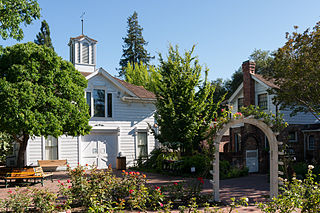
A parade is a procession of people, usually organized along a street, often in costume, and often accompanied by marching bands, floats, or sometimes large balloons. Parades are held for a wide range of reasons, but are usually celebrations of some kind.

Carnival or Shrovetide is a festive season that occurs at the close of the Christian pre-Lenten period, consisting of Quinquagesima or Shrove Sunday, Shrove Monday, and Shrove Tuesday or Mardi Gras.

Santa Rosa is a city in and the county seat of Sonoma County, in the North Bay region of the Bay Area in California. Its population as of the 2020 census was 178,127. It is the largest city in California's Wine Country and Redwood Coast. It is the fifth most populous city in the Bay Area after San Jose, San Francisco, Oakland, and Fremont; and the 25th-most populous city in California.

Windsor is an incorporated town in Sonoma County, California, United States. The town is 9 miles north of Santa Rosa and 63 miles north of San Francisco. The population was 26,344 as of the 2020 census.

Moomba is held annually in Melbourne, Australia. Run by the City of Melbourne, it is Australia's largest free community festival. The Melburnian tradition is celebrated over four days, incorporating the Labour Day long weekend, from Friday to the second Monday in March. Moomba is culturally important to Melbourne, having been celebrated since 1955, and regularly attracts up to a million people, with a record attendance of 3.8 million set in 2018.

The Portland Rose Festival is an annual civic festival held during the month of June in Portland, Oregon. It is organized by the volunteer non-profit Portland Rose Festival Foundation with the purpose of promoting the Portland region. It includes three separate parades, along with a number of other activities.
Santa Rosa Junior College (SRJC) is a public community college in Santa Rosa, California with an additional campus in Petaluma and centers in surrounding Sonoma County. Santa Rosa Junior College was modeled as a feeder school for the University of California system. SRJC is governed by the Sonoma County Junior College District (SCJCD).
The Lytton Band of Pomo Indians is a federally recognized tribe of Pomo Native Americans. They were recognized in the late 1980s, as lineal descendants of the two families who lived at the Lytton Rancheria in Healdsburg, California from 1937 to about 1960. The tribe now has around 275 enrolled members. It has a casino in San Pablo, California, and has proposed to build housing for tribe members, plus a winery and a hotel, just west of Windsor, California, in Sonoma County.

Luther Burbank Home and Gardens is a city park containing the former home, greenhouse, gardens, and grave of noted American horticulturist Luther Burbank (1849-1926). It is located at the intersection of Santa Rosa Avenue and Sonoma Avenue in Santa Rosa, California, in the United States. The park is open daily without charge; a fee is charged for guided tours. It is designated as a National Historic Landmark as well as a California Historical Landmark (#234).

Charles M. Schulz–Sonoma County Airport is a domestic airport located 7 miles (11 km) northwest of downtown Santa Rosa, California, in Sonoma County, California, United States.

Nisei Week is an annual festival celebrating Japanese American (JA) culture and history in Little Tokyo, Los Angeles. Nisei means 2nd generation in Japanese, describing the first American born Japanese, a group which the seven-day festival was originally meant to attract. Though named for the Nisei generation, Nisei Week is no longer targeted at Niseis, nor is the festival still contained within a week. Nisei Week Foundation president for 2006, Michelle Suzuki, described the festival as "the opportunity for people of all backgrounds to celebrate Japanese heritage and culture".

Luther Burbank was an American botanist, horticulturist and pioneer in agricultural science. He developed more than 800 strains and varieties of plants over his 55-year career. Burbank's developments included those of fruits, flowers, grains, grasses, and vegetables. He developed a spineless cactus and the plumcot.

The Museum of Sonoma County, commonly known as the Sonoma County Museum, is a non-profit organization located in downtown Santa Rosa, California. Its 7th St. campus comprises the historic 1910 Santa Rosa Post Office, a contemporary art gallery, and a sculpture garden. Between the two buildings, the Museum presents 10-12 rotating exhibitions per year and maintains a permanent collection of over 18,000 objects that document the region's rich history and celebrate local artists. The historic post office is on the National Register of Historic Places.

The Luther Burbank Center for the Arts, and previously known as the Wells Fargo Center for the Arts from March 2005 to March 2016) is a performance venue located just north of Santa Rosa, California, near U.S. 101. The facility is owned and operated by the Luther Burbank Memorial Foundation, a non-profit arts organization established in 1979.
The Joe Rodota Trail is a 8.5-mile paved rail trail in Sonoma County, California that spans from near the intersection of Mill Station Road and Highway 116 in Sebastopol to the area of West 3rd Street and Roberts Avenue in Santa Rosa. The trail provides a safety separation for pedestrians and bicycles from motor vehicle traffic on the parallel California State Route 12/Luther Burbank Memorial Highway.
Carnival in Mexico is celebrated by about 225 communities in various ways, with the largest and best known modern celebrations occurring in Mazatlán and the city of Veracruz.

Graton Resort & Casino is an Indian casino and hotel outside Rohnert Park, California, that opened on November 5, 2013. It is owned and operated by the Federated Indians of Graton Rancheria. The casino has 3,000 slot machines, 144 table games, and a poker room. In November 2016 it opened an adjacent hotel with 200 rooms.

Santa Rosa Downtown station is a Sonoma–Marin Area Rail Transit train station in Santa Rosa. It opened to SMART preview service on July 1, 2017; full commuter service commenced on August 25, 2017. It is located west of Wilson Street between 4th and 5th Streets, across the U.S. Route 101 freeway from downtown at the site of the ex-Northwestern Pacific Railroad station building. The station is the focal point of the Railroad Square Historic District, a National Register of Historic Places historic district designated in 1979.
Gaye Theresa LeBaron is an American newspaper columnist, author, teacher, and local historian of Sonoma County, California. She wrote more than 8,000 columns for The Press Democrat from 1961 until her semi-retirement in 2001. She also co-authored two books on the history of Santa Rosa, California.

The Tubbs Fire was a wildfire in Northern California during October 2017. At the time, the Tubbs Fire was the most destructive wildfire in California history, burning parts of Napa, Sonoma, and Lake counties, inflicting its greatest losses in the city of Santa Rosa. Its destructiveness was surpassed only a year later by the Camp Fire of 2018. The Tubbs Fire was one of more than a dozen large fires that broke out in early October 2017, which were simultaneously burning in eight Northern California counties, in what was called the "Northern California firestorm". By the time of its containment on October 31, the fire was estimated to have burned 36,810 acres (149 km2); at least 22 people were believed to have been killed in Sonoma County by the fire.













